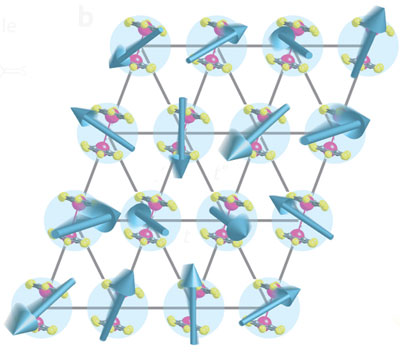| Posted: August 13, 2010 |
Comparative study highlights the unusual properties of quantum spin liquids |
|
(Nanowerk News) A growing body of experimental evidence is lending support to the theory that an exotic state of matter called a quantum spin liquid actually exists. In a quantum spin liquid, the way electrons spin on their axes lacks any sense of organization throughout the material—even at temperatures approaching absolute zero, where order tends to reign supreme. However, definitive proof has proved elusive, particularly in two-dimensional systems.
|
|
Signatures of a quantum spin liquid have now been observed in an organic insulator by Reizo Kato at the RIKEN Advanced Science Institute, Wako, working in collaboration with researchers from Kyoto University and the Japan Science and Technology Agency ("Highly Mobile Gapless Excitations in a Two-Dimensional Candidate Quantum Spin Liquid").
|
|
In a quantum spin liquid, the magnetic arrangement of the material is incompatible with the underlying crystal geometry, thus preventing the spin from showing any order (Fig. 1). "This leads to liquid-like properties among the spins, even at absolute zero temperature," explains Kato. In contrast, molecules in ice arrange into a crystalline lattice—a pattern maintained throughout the material.
|
 |
| Figure 1: A schematic diagram of a quantum spin liquid. The electron spins, indicated by blue arrows, show no long-range ordering even at low temperatures.
|
|
The team compared two closely related organic insulators EtMe3Sb[Pd(dmit)2]2 (abbreviated as dmit-131) and Et2Me2Sb[Pd(dmit)2]2 (abbreviated as dmit-221). Scientists previously proposed that dmit-131 may show quantum-spin-liquid state properties. Indeed, using nuclear magnetic resonance measurements, scientists have never identified any long-range magnetic order at temperatures as low as 19 millikelvin. The reason for this remains unclear. The crystal structure of dmit-221 is very similar; however, it exhibits a charge-ordered state. Kato and colleagues therefore thought that a comparison between the two should reveal any properties particular to quantum spin liquids.
|
|
The researchers measured the thermal conductivity at temperatures between 10 and 0.1 Kelvin, since one of the most important experimental parameters is the thermal conductivity divided by the temperature. In dmit-221, this parameter approaches zero as the temperature gets closer to absolute zero. "This is typical behavior of insulators where lattice vibrations carry thermal energy," says Kato. In dmit-331, however, they extrapolated the parameter to be nonzero at 0 Kelvin. "This is more akin to metallic behavior where free electrons carry the thermal energy." This indicates the presence of so-called 'gapless excitations', meaning that there is no energy gap between the ground state and excited states. However, there is also some evidence for spin-gap-like excitations.
|
|
These results indicate that this system is a quantum spin liquid with a dual nature. "The next step is to address the fundamental question of whether a quantum spin liquid undergoes instabilities other than classical ordering," Kato notes.
|

